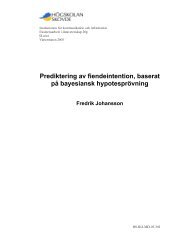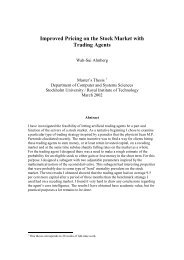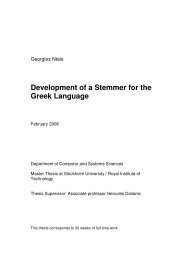Modeling Hydra Behavior Using Methods Founded in Behavior-Based Robotics
Modeling Hydra Behavior Using Methods Founded in ... - SAIS
Modeling Hydra Behavior Using Methods Founded in ... - SAIS
You also want an ePaper? Increase the reach of your titles
YUMPU automatically turns print PDFs into web optimized ePapers that Google loves.
7.2. Generation of behavioral organizer 417.2 Generation of behavioral organizerAs previously described, a priority-based <strong>in</strong>teraction of the behaviors <strong>in</strong> <strong>Hydra</strong> is suggested<strong>in</strong> the literature. Thus, behavioral organization us<strong>in</strong>g the CSA is straight-forward,and can be accomplished by organiz<strong>in</strong>g the behaviors <strong>in</strong> layers with respect to priorities,us<strong>in</strong>g switches of suppression type for the behavioral <strong>in</strong>ter-connections. Fig. 7.10 showsthe result<strong>in</strong>g behavioral model.B4: Feed<strong>in</strong>gB3: Response to light✓✏ ❄S✒✑MotivationalstateB2: Response to mechanical stimulus✓✏ ❄S✒✑<strong>Hydra</strong>actionB1: Spontaneous actions✓✏ ❄S ✲✒✑Figure 7.10: Structure of colony-style behavioral organizer for the behaviors of <strong>Hydra</strong>. Here, Srepresents switches of suppression-type.In behavior selection situations, <strong>in</strong> biological organisms as well as <strong>in</strong> artificial systems, itis common that some trade-off is necessary [40]. Thus, it would be desirable to <strong>in</strong>vestigateto what extent the suggestion of priority-based behavior organization <strong>in</strong> <strong>Hydra</strong> holds.However, not enough results from experiments on the physical animal were found <strong>in</strong> theliterature to enable such an <strong>in</strong>vestigation at this po<strong>in</strong>t. In Chapter 8, recommendationsfor further experiments with respect to this are discussed. To validate the model <strong>in</strong> otheraspects, a set of simulation experiments were carried out, the results of which will nowbe described.7.2.1 Experiment A: Spontaneous locomotion patternsWagner recorded the position of <strong>Hydra</strong>, when the animal was left undisturbed for severaldays. His results suggest that the spontaneous locomotion behavior of <strong>Hydra</strong> is much like





